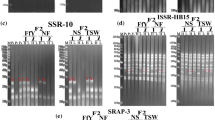Abstract
The use of isozymes as indicators of genetic diversity and as markers for the selection of agronomic traits has been proposed in different crop species. The present investigation was conducted to study the use of isozyme-derived genetic distance between parents in predicting the F1 heterosis in Indian mustard. In addition, the interaction of isozyme-based diversity with quantitative trait and pedigree-based diversity measures, and its role in predicting hybrid heterosis has also been examined. Sixteen Indian mustard lines and their 48 crosses (12 × 4, line x tester crossing) were evaluated over two environments for isozyme and quantitative morphological characters. The results from this study suggest that the heterotic response to isozymic changes is more responsive in crosses derived from morphologically and pedigree-wise related parents in comparison to crosses derived from unrelated parents. It was possible to improve heterosis predictions by partitioning the isozyme-based genetic distance into general genetic distance and specific genetic distance and correlating the latter with the specific combining ability of morphological traits. The possible reasons for these observations are discussed.
Similar content being viewed by others
References
Charcosset A, Lefort-Buson M, Gallais A (1991) Relationships between heterosis and heterozygosity at marker loci: a theoretical computation. Theor Appl Genet 81:571–575
Cox TS, Murphy JP (1990) The effect of parental divergence on F2 heterosis in winter wheat crosses. Theor Appl Genet 79:241–250
Cox TS, Kiang YT, Gorman MB, Rodgers DM (1985) Relationship between coefficient of parentage and genetic similarity indices in soybean. Crop Sci 25:529–532
Dobzhansky T (1952) The nature and origin of heterosis. In: Gowen JW (ed) Heterosis. Iowa State University Press, Ames, pp 218–223
Frei OM, Stuber CW, Goodman MM (1986) Use of allozymes as genetic markers for predicting performance in maize single-cross hybrids. Crop Sci 26:37–42
Geredes JT, Tracy WF (1994) Diversity of historically important sweet corn inbreds as estimated by RFLPs, isozymes and pedigree. Crop Sci 34:26–33
Kempthorne O (1957) An introduction to genetic statistics. John Wiley and Sons, New York, Chapman and Hall, London
Moser H, Lee M (1994) RFLP variation and genealogical distance, multivariate distance, heterosis, and genetic variance in oats. Theor Appl Genet 87:947–956
Mumm RH, Hubert LJ, Dudley JW (1994) A classification of 148 U. S. maize inbreds. II. Validation of cluster analysis based on RFLPs. Crop Sci 34:852–865
Sekhon MS (1991) Biochemical diversity in relation to genetic divergence in Indian mustard (Brassica juncea). PhD thesis, Punjab Agriculture University, Ludhiana, Punjab
Sekhon MS, Gupta VP (1992) Seed isozyme differences of parents and single-cross performance in Indian mustard (Brassica juncea L.). J Genet Breed 46:203–208
Smith OS, Smith JSC, Bowen SL, Tenborg RA, Wall SJ (1990) Similarities among a group of elite maize inbreds as measured by pedigree, F1 grain yield, grain-yield heterosis and RFLPs. Theor Appl Genet 80:833–840
Souza E, Sorrells ME (1991) Prediction of progeny variation in oats from parental genetic relationships. Theor Appl Genet 82: 233–241
Suarez JC, Graef GL, Fehr WR, Cianzo SR (1991) Association of isozyme genotypes with agronomic and seed-composition traits in Soybean. Euphytica 52:137–146
Thorpe ML, Duke LH, Beversdorf WD (1987) Procedures for the detection of isozymes of Rapeseed (Brassica napus and B. campestris) by starch-gel electrophoresis. Technical bulletin. Department of crop science, University of Guelph, Guelph, Ontario, pp 22–42
Author information
Authors and Affiliations
Additional information
Communicated by J. Mac Key
Rights and permissions
About this article
Cite this article
Sekhon, M.S., Gupta, V.P. Genetic distance and heterosis in Indian mustard: developmental isozymes as indicators of genetic relationships. Theoret. Appl. Genetics 91, 1148–1152 (1995). https://doi.org/10.1007/BF00223933
Received:
Accepted:
Issue Date:
DOI: https://doi.org/10.1007/BF00223933




